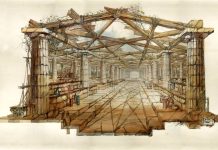Modernism in architecture emerged at the beginning of the 20th century. It was a natural consequence of the growing feeling in avant-garde circles that changes in industrial society lifestyles required a completely new approach to architectural design and urban planning.
In France it was Le Corbusier who significantly manifested the need to establish new principles, objectives, and an entire architecture media to follow the democratic changes in society after World War I. We have new optics and new social life, but we didn’t match to them our house (…) In the new world there can be no place for the aesthetics of the École des Beaux-Arts, defending its conservative and endangered position in culture, nor the structural rationalism of École Polytechnique.
It is necessary to establish a new style, other than that ‘false’, and based on the truth, unmasked unnecessary ‘decorum’, for which the pattern is to be perfect in the form and function of the transatlantic architecture, and the test of the new ‘object type ‘ of daily use, which govern only convenience and hygiene.
Elsewhere he writes architecture becomes a mirror of the era. Modern architecture is home to ordinary people. It allows the palaces to fall. It’s also a sign of the times. To analyze the house for the ordinary man, for ‘everybody’ to find the human foundation, human scale, typical need, a typical function; typical emotions. Please! That’s most important, including everything. The time has come for dignity, man must abandon the exhibit!
In the sense of a social mission, there was an attempt to build new principles of spatial and social policy, free from the problem of private property, and create new aesthetic patterns unburdened by 19th-century stylistics. It was in fact a revolutionary change of understanding of architecture in its complexity connecting structure, form, space, and urbanism with the goals of industrial and social development.
In the face of modernist doctrine, the academic definitions of architecture formulated at the end of the 19th century by the English art critic John Ruskin: “Architecture is nothing but an ornament added to the building” and “Architecture is about what is not necessary” and Jan Sas Zubrzycki: “Construction is the foundation of architecture, and architecture is the beautification of construction” sounded archaic, even ridiculous.
The architect, freed from the previous restrictions resulting from the observance of the stylistic canon, became an authentic creator, defining their individual style based on the expression of a “pure” abstract form following the planned functions and rational structure while exposing used materials. Thanks to mass transport, it was possible to create a new model of the city, more open and spacious.
Furthermore, the necessity for reconstruction after the devastation of World War I and the widely available means of mechanical production stimulated the making of brave urban assumptions on an unprecedented scale. Many architects took up these challenges with enthusiasm and faith in the social mission of their profession without foreseeing the implications of their most arbitrary design decisions.
In academic circles, however, the conviction grew of the need to protect the traditional artistic values in the architecture, saved, for example, in the Vitruvian triad Firmitas, Utilitas Venustas as a condition for maintaining the prestige of the profession. These two opposing approaches impacted the emergence of the avant-garde movement in architecture and planning, influenced by experiences coming mainly from two continents: European and American, but also as a result of fascination with the culture of the Far East.
The search for a new expression in architecture was a response to the widespread chaos and eclecticism prevailing in the 19th-century styles borrowing of historical forms.



















